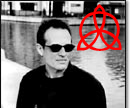

For most organ parts on Led Zeppelin's albums,
Jones used a larger Hammond -- the C3 model. In England, the C3 was very
common, and groups like Deep Purple, Fleetwood Mac, and Keith Emerson
of ELP used it. The C3 was identical sonically to the B3, but with a different
wooden casing. The C3's casing surrounded the organ on all sides. Instead
of these solid wooden sides, the famous B3 had legs supporting the organ,
making it somewhat lighter and more portable.
 |
|
A Hammond C3
|
John Paul Jones often recorded with a Hammond
C3, and it was a common instrument on many of their early tours. Led Zeppelin's
most memorable organ track, "Thank You," was recorded in 1969 at Morgan
Studios in London. On this song, Jones' beautiful organ parts are the
main support during the verses. His style here reflects his many years
playing organ in church as a boy. The organ is restrained, with no vibrato
or distortion, and avoids sounding like a blues or jazz instrument. A
tape delay, which echoes the organ track in the opposing speaker, creates
an echo effect that enhances the "church" mood. At the same studio sessions,
"Since I've Been Loving You" was recorded, but it was not released until
Led Zeppelin III a year later.
"Since I've Been Loving You" became one of Led Zeppelin's most outstanding
songs. Its extreme dynamics and fascinating chord progression show how
Led Zeppelin were able to modify the traditional 12-bar blues. They would
play it at nearly every concert for ten years, and it seemed to exemplify
both the subtlety and power that the band possessed. Jones' Hammond organ
is the perfect choice for this track, as its expression allows for subtle,
quiet support to the verses, along with strong, exciting power during
the choruses. By carefully working the volume (or "swell") pedal, Jones
takes the organ from clear, pure organ tones to a more distorted, heavy
overdrive that matches and enhances the powerful climaxes. The Leslie
speaker is recorded with two microphones, panned wide apart for stereo;
the main microphone sound is bright and sharp, and clearly indicates the
textural changes of the track. The other microphone channel is almost
entirely without treble and is panned to the left to fill the "space"
behind the guitar. This creates a wide full sound without interfering
with the balance between the organ and guitar, which are on opposite sides.
The "bass" track is Hammond organ, as well, that was recorded seperately
for clarity.
"Night Flight" from Physical Graffiti is another traditional organ
sound; the Hammond is fed through the Leslie, and slightly distorted.
During the song, Jones plays basic chord changes and uses the Leslie speed
changes to add excitement to the choruses.
On the early Led Zeppelin tours, there was often a C3 or B3, but it was
likely that these heavy instruments were made available for each show,
rather than the group carrying one from city to city. (At the time, Hammond
organs were very common, and many halls had one available.) The Hammond
was a very common sight on Jones' right side of the stage from 1970 until
1975. The Hammond was always run through a Leslie speaker, which has become
the traditional way to amplify a Hammond. The Leslie speaker contains
an amplifier and "spinning speaker" system that gives the sound animation
and energy. Unfortunately, the Leslie amp was only 45 watts -- certainly
not enough to be heard clearly on the loud stages of Led Zeppelin. So,
the band would put the Leslie offstage in the dressing room and place
microphones near it to send sound to the mixer. This clever arrangement
created problems on a few occasions! Jones recalls: "People used to go
in to the dressing room and shout things over the microphones. It would
come over the PA... (laughs)." By the 1977 tour though, Jones was regretting
not taking the Hammond with him, but admitted that there were already
too many keyboard instruments covering the stage. There just was not enough
room for it.